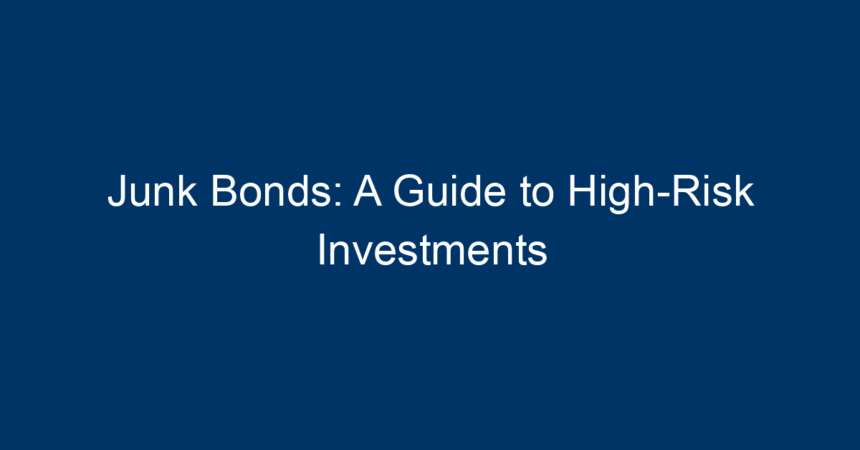Investors constantly seek ways to grow their portfolios, and often, higher returns come with higher risks. One of the most polarizing yet increasingly popular investment options is junk bonds. These high-yield bonds can offer significant rewards, but they also come with substantial risks that could impact your financial future. In this comprehensive guide, we’ll delve into the world of junk bonds, explore their characteristics, understand the risks involved, and provide actionable insights to navigate this complex investment landscape.
What Are Junk Bonds?
Definition and Features
Junk bonds, also known as high-yield bonds, are debt securities that are rated below investment grade by major credit rating agencies. These bonds are issued by companies or entities that, while potentially promising high returns, carry a greater risk of default. The lower credit ratings reflect the issuer’s financial instability or a higher likelihood of not being able to meet interest payments.
Ratings Explained
Credit rating agencies such as Moody’s, S&P, and Fitch assign ratings to bonds based on the issuer’s creditworthiness. Junk bonds typically fall into the "BB" category or lower according to S&P ratings. The yield on these bonds is significantly higher than investment-grade bonds, compensating investors for the increased risk involved.
Why Invest in Junk Bonds?
High Yields
The most enticing feature of junk bonds is their potential for high yields. Investors are often lured by interest rates that can sometimes reach double digits, providing lucrative returns if the issuer does not default.
Portfolio Diversification
Incorporating junk bonds into a diversified portfolio can help balance risk and reward. While the overall market moves might negatively impact high-quality bonds, junk bonds can behave differently. This makes them a potential hedge during turbulent times in financial markets.
Economic Recovery Opportunities
Investing in junk bonds can be particularly appealing during periods of economic recovery. As companies start to thrive post-recession, previously issued junk bonds could significantly increase in value.
Understanding the Risks of Junk Bonds
Default Risk
The primary risk associated with junk bonds is default risk. Since these bonds are issued by less stable companies, the possibility of the issuer failing to pay interest or principal is considerably higher compared to investment-grade bonds.
Interest Rate Risk
Like all bonds, junk bonds are susceptible to interest rate fluctuations. Rising interest rates often lead to declining bond prices. This can result in investors facing losses if they need to sell their bonds before maturity.
Market Risk
The market conditions can greatly affect the performance of junk bonds. Economic downturns, industry-specific issues, or broader market turmoil can lead to surges in defaults and decreases in bond prices.
How to Invest in Junk Bonds
Direct Investments
Investors can purchase junk bonds directly from issuers or on the secondary market. Understanding the specific bond’s yield, maturity, and the issuing company’s financial health is crucial when opting for direct investments.
Bond Funds
For those who prefer a diversified approach, junk bond funds offer a viable alternative. These mutual funds or exchange-traded funds (ETFs) pool capital from numerous investors to buy a range of junk bonds, thereby spreading the risk across various securities.
Risk Assessment
Before investing in junk bonds, assess your risk tolerance. Given the high volatility and potential for loss, it’s essential to have a sound understanding of your financial goals and how junk bonds fit into your overall investment strategy.
Key Factors to Consider When Investing in Junk Bonds
Credit Quality
Inspect the credit quality of the bond and the issuing company. Due diligence on financial health, industry performance, and credit ratings will offer insights into the likelihood of default.
Yield Comparison
Compare the yield of junk bonds with other fixed-income securities. A higher yield might seem attractive, but it is essential to ensure it compensates adequately for the risks involved.
Economic Conditions
Be aware of the economic environment before making investments. Junk bonds tend to perform better when the economy is strong and companies are likely to thrive.
The Future of Junk Bonds
Trends and Predictions
The current market trend indicates that as interest rates rise, investors could see increased opportunities in the junk bond market. Conversely, economic volatility might lead to higher default rates. Keeping an eye on economic forecasts and market trends can provide insight into potential investment opportunities.
Regulatory Environment
Changes in regulations can also impact the junk bond market. Staying updated on any policy changes will equip investors with better knowledge of factors that could affect their investments.
Conclusion: Navigating the Junk Bond Landscape
Investing in junk bonds can be a rollercoaster ride. The allure of high returns is enticing, but the risks are real. Whether you choose to invest directly or through bond funds, understanding the characteristics of junk bonds and the potential pitfalls is crucial.
Actionable Insights
-
Research Thoroughly: Before investing, ensure you conduct thorough research about the specific bond and its issuer.
-
Diversify Your Portfolio: To mitigate risk, include a mix of investments (like stocks, high-grade bonds, and junk bonds) in your portfolio.
- Stay Informed: Regularly monitor economic indicators and market trends that could impact your investments in junk bonds.
By arming yourself with knowledge and being prepared for the ups and downs of the junk bond market, you can turn high-risk investments into fruitful opportunities. Remember, as with any investment, it’s essential to do your homework and invest responsibly.




